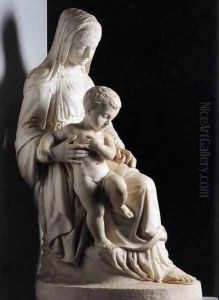Jan Robert Calloigne Paintings
Jan Robert Calloigne was a Belgian sculptor and printmaker born on August 4, 1775, in Bruges. He was a prominent figure in the artistic scene during the late 18th and early 19th centuries. Calloigne's early life and training are not thoroughly documented, but it is known that he was active during a period when Neoclassicism was the dominant artistic style in Europe, which certainly influenced his work.
Calloigne's sculptures often reflected the classical ideals of beauty, balance, and symmetry, which were typical of the Neoclassical movement. He was skilled in carving marble and other materials, creating both public monuments and smaller, more personal works. In addition to his sculptural endeavors, Calloigne also produced a number of prints. As a printmaker, he worked with etchings and engravings, which were popular methods of art reproduction at the time.
Despite his talent, Calloigne did not gain the same level of fame as some of his contemporaries. However, he was respected by his peers and contributed to the artistic heritage of Belgium. He worked at a time when Belgium was undergoing significant political and social changes, transitioning from Austrian rule, through the French Revolutionary and Napoleonic periods, and into the establishment of the Kingdom of Belgium in 1830.
Jan Robert Calloigne passed away on March 7, 1830, just before the formal establishment of Belgium as an independent nation. His works remain a part of the country's rich cultural history, with some pieces likely housed in Belgian museums or forming part of private collections. Although not widely known today, his contributions to Neoclassical sculpture provide insight into the era's artistic trends and the cultural landscape of the Low Countries during a transformative period in European history.
